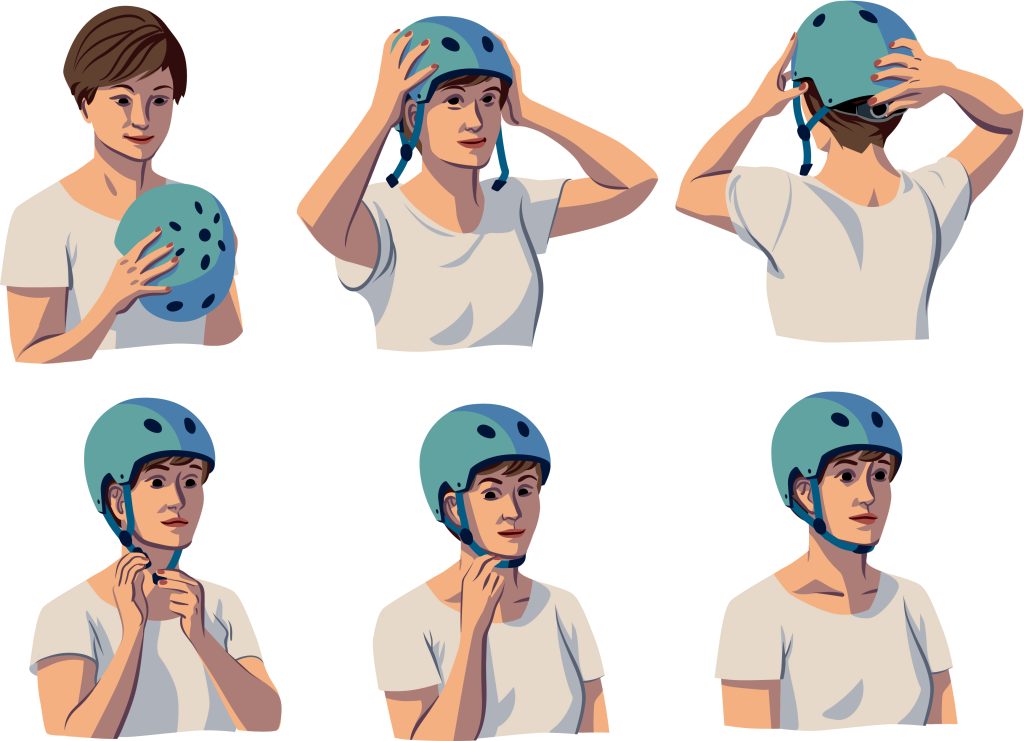
Cycling helmet
A helmet is important protective gear for cyclists. The helmet protects the head in the event of an accident. A fall can be enough to cause a head injury. An appropriately sized and well-fitting helmet provides the best protection.
According to the Road Traffic Act (section 92), cyclists and bicycle passengers are generally required to wear a protective helmet. The importance of cycling helmets is well recognised. The Finnish Road Safety Council asked people’s opinions about helmet use in summer 2020. Only 13% of respondents felt that cycling helmets are unnecessary and are needed only by small children and insecure cyclists.
The Finnish Road Safety Council carries out annual monitoring of the use of cycling helmets across Finland. Helmets have become gradually more common. In 2024, 58% of cyclists wore a helmet. Helmet use is most common in the Helsinki metropolitan area, and overall most common in children.
The cycling helmet standard
Cycling helmets must be CE approved. The European standard for cycling helmets is EN 1078. The cycling helmet includes shock-absorbing components and fasteners that keep the helmet in place during accidents. In an EN 1078-compliant cycling helmet, the fastening system keeps the helmet in place during a collision.
The standard requires cycling helmets to be lightweight. They should also be ventilated, easy to use and able to be worn with eyeglasses. The helmet should not significantly impair the user’s ability to hear traffic noise.
The helmet receives part of the impact energy and thus reduces the impact to the head. The impact can result from falling or colliding with someone. A standard-compliant helmet has passed the shock absorption test. In the test, the helmet is fitted to a 5 kg dummy head and dropped from a height of 1.5m, and the peak acceleration sustained by the head is max. 250g (g = free fall acceleration). Without shock absorption, the head could sustain acceleration of up to 1,000g.
Selection and use of a cycling helmet
An appropriately sized and well-fitting helmet provides the best protection. Try different models to find one that fits your head well. Cycling helmets are being continuously tested and developed. There are links to American, Swedish and German studies at the end of this article.
Follow your head: there are various types of helmet models, and you should choose one that feels well-fitted and comfortable to wear. A brightly coloured helmet improves visibility on the road.
Ensure forehead protection: the helmet is worn so that it protects the forehead, which is most susceptible to impacts.
Adjust to fit: helmets can be adjusted to suit the user by means of the adjustment band or bits. Place the straps on both sides of your ears. The strap guide is placed below the ear. Finally, adjust the chin strap so that it feels secure and comfortable. You should be able to fit only one or two fingers between the strap and your jaw. A well-secured helmet won’t fly off the head in the event of an accident.
Helmet markings: CE, EN 1078, manufacturer and helmet name, size, weight, manufacturing period.
A good helmet:
- is appropriately sized and shaped
- covers the forehead
- is securely attached and
- is CE approved.

The service life of a cycle helmet
The helmet acts as a shock absorber. The harder the impact, the more the shock-absorbing material is compressed. The material also distributes the impact over a wider area, which also helps to reduce injury.
Each impact reduces the helmet’s shock absorption capacity, even though it might appear intact. A helmet that has clear cracks or deep cuts should be replaced. However, some damage may not be visible.
The use and storage conditions of the helmet affect its service life. Helmet manufacturers usually recommend changing the helmet every 3–5 years. The recommendation is based on so-called normal use. The instructions usually recommend avoiding leaving the helmet in places such as cars, where it can be exposed to heat. Further information about replacement recommendations is provided in the helmet’s user instructions or from the manufacturer.
Cycling helmets protect against head injury
Bicycle falls and collisions are much more common than statistics suggest. The majority of cycling accidents are isolated falling incidents. In adults, head injuries are usually caused by hitting the road, and in children by being hit by a car. Limb injuries are more common, but head injuries are often more serious. Even small head injuries can be serious, painful and slow to heal.
The protection provided by the helmet depends on the accident, and the helmet cannot always prevent fatalities and injuries. The use of a cycling helmet does not prevent accidents, but it does give protection against head and brain injuries should an accident happen.
The protective properties of helmets have been examined in several studies. In 2016, Olivier & Creighton carried out an extensive meta-analysis of the protective effect of the cycling helmet. This meta-analysis covered 40 studies and 64,000 cycling accidents. The use of a cycling helmet decreased the likelihood of head injuries by 51%, serious head injuries by 69%, facial injuries by 33% and fatal head injuries by 65%. Høye’s 2018 meta-analysis included 55 studies from 1989–2017. The use of a cycling helmet reduced head injuries by 48%, serious head injuries by 60%, traumatic brain injuries by 53%, facial injuries by 23% and the number of fatalities or life-changing injuries by 34%.
According to the Finnish Crash Data Institute, in fatal cycling accidents in the 2017–2019 period, 41 cyclists had not worn a helmet. Calculated using various probabilities, a helmet could have saved a third of them (14). When assessing the protection effect of helmet use, it should be noted that cyclists who have been saved by a helmet have not been included in the data.





